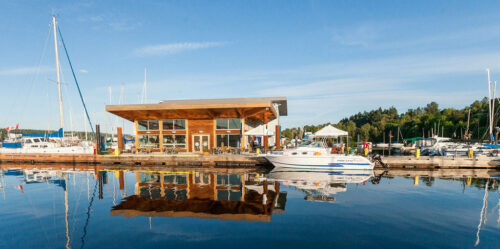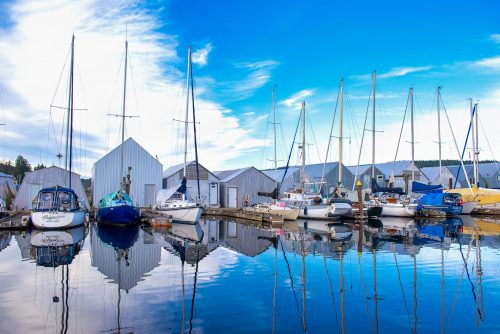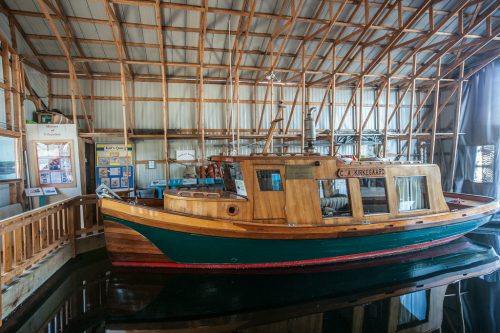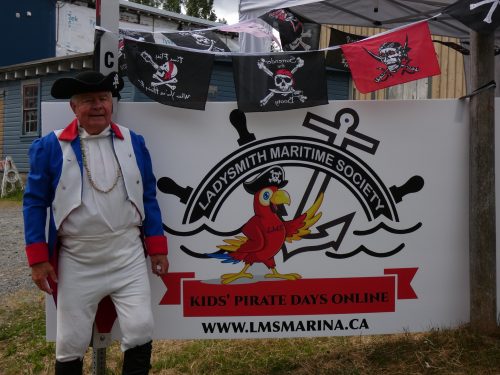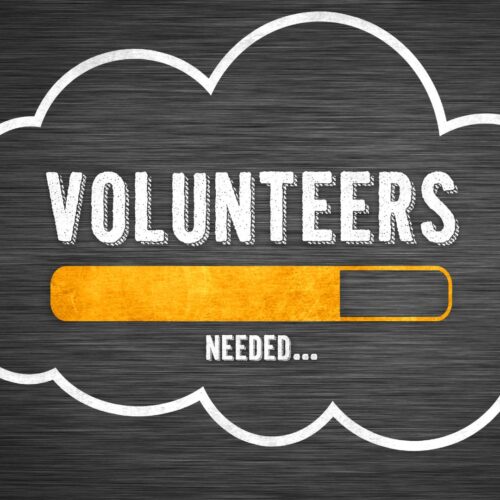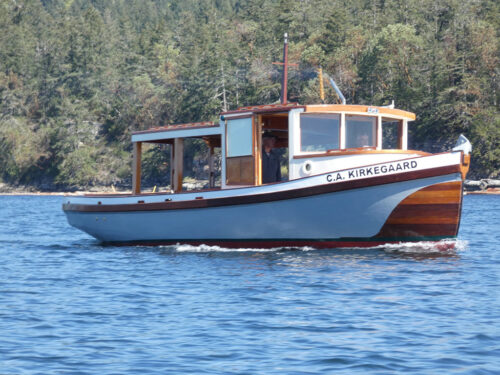Posts by LMS Admin
LMS in the Media: B.C.Conservative Party Leader meets with Ladysmith Maritime Society.
On Tuesday 2nd July, the B.C Conservative Party leader, John Rustad met with members and supporters of Ladysmith Maritime Society to show support and listen to concerns about the recent transfer of the Ladysmith Community Marina, and ongoing dispute about assets, such as the Welcome Centre.
“People have put decades into the society … and for it to transfer over like this without the engagement or discussion, to me that’s just the wrong way that things should be done,” Rustad said.
For coverage of the meeting which attracted dozens of supporters, please follow the links:
Ladysmith Maritime Society: The BC Government Must Take Responsibility For Millions In Losses
The Ladysmith Maritime Society has been a fixture of Ladysmith’s waterfront for nearly four decades. In addition to successfully operating the community marina, bringing thousands of people together at the waterfront each year for community events, LMS has a history investing back into the infrastructure that makes maintaining our heritage and providing space to boaters possible.
That is until the Government of British Columbia, supported by the Town of Ladysmith, decided to give away the marina that LMS developed and maintained, along with 90% of the organization’s revenue without compensation, in the name of reconciliation.
We all agree that the aims of reconciliation are important and believe that for a government who appears as committed to this course as the BC NDP are, that they would have thought through a fair and sensible approach to ensure they aren’t sinking community organizations and others in their wake.
It is naive to believe that the government can act in a way that takes millions of dollars from a vital community organization like LMS to ‘create’ economic opportunities as part of reconciliation without hurting the cause of reconciliation or creating fear among British Columbians about what further agreements could mean for them.
The erosion of public trust is in the hands of Government Ministers who think they can hide from the problems they have created by refusing to engage with non-indigenous stakeholders whose futures they are negotiating before, during or after such agreements are being made.
LMS supports reconciliation and acknowledges the Crown’s relationship with British Columbia’s indigenous people has been marked by injustice, and has caused trauma and hardship. If we as a society are to move on from the damage of these actions, it is important that the government learn its lessons and not continue to divide communities and cause hardship, now under the banner of reconciliation.
Just last year, the Province was ordered to pay a private hydro electric developer over $10 million dollars for a project rejection that was determined by the courts to be a “misfeasance of government representatives”, which is how the court ruling summed up a rejection of a project made for political reasons that aligned with the province’s reconciliation agenda.
The concerns regarding the Pender Harbour Dock Management Plan and the failed Land Act changes highlight a province that is fearful of how this government is handling these issues.
In our case, after the damage was done, LMS asked the government for compensation for our assets, which they have confiscated and given away. We’ve asked for financial support to enable us to seek a new home on the Ladysmith waterfront, help with permitting and funding to start again, and we’ve asked for help in storing our boathouses and heritage boats in the interim.
We submitted a plan to the government and opposition parties with a path to resolving these issues. Despite months of opportunity, we’ve heard nothing but silence from Ministers and the Premier. Not one BC NDP MLA has agreed to speak with us.
The silence by the BC NDP on this issue is deafening. As they continue to refuse to hear the voices of those they’ve harmed with their reconciliation policies, they risk not only undermining public support in the process, but also losing support to political parties that are willing to engage with all affected stakeholders.
LMS remains committed to working collaboratively towards a just future for all British Columbians,but cannot do that alone. We are calling on the government to live up to its responsibilities and engage with us directly to address the damage caused by their actions.
Ultimately, if the BC NDP choose to continue to hide, it will be no surprise when concerned citizens across British Columbians stand together to take on this unjust approach as a united front.
Ladysmith Maritime Society
Please contact Richard Wiefelspuett, Executive Director for further comments and information.
Breaking News: Ladysmith Maritime Society in National Media
Ladysmith Maritime Society has caught the attention of our national media.
Richard Wiefelspuett, our executive director was interviewed by the CBC’s Claire Palmer on Sunday in the marina parking lot with the familiar background of our former community marina.
The interview aired on CBC Vancouver TV during the 11 pm news.
Here’s the link: https://www.youtube.com/watch?v=IbEacKeDdHM
The Ladysmith segment starts at 11:17 (minutes: seconds) into the clip.
There was also a brief segment in French on IcI-Colombie-Britannique CBC radio this morning.
Here’s the link:
https://ici.radio-canada.ca/nouvelle/2048762/marina-ladysmith-gestion-bataille-societe
Thank you to all of you who worked hard to bring our story to the media.
LMS Advocates for Collaboration Amidst Marina Dispute
After the unsuccessful injunction hearing in late December 2023, LMS has been strategizing for a future without the operation of its Ladysmith Community Marina program. Encouraged by the Town Council Resolution on December 5, 2023, and the subsequent Rise and Report on January 23, 2024, LMS has formulated plans to maintain a presence in the marina, focusing on the continued operation of the Museum and the Heritage Boatshed (commonly known as the “Bill Adair Shed”).
The Town’s resolution has allocated moorage costs for these two boathouses and an additional 20 feet of dock space, presumably facilitating public access to customary maritime exhibitions, and events. However, an outstanding disagreement persists regarding the ownership of LMS’ boathouses and the entire marina infrastructure, prompting recent communications wherein LMS has expressed its commitment to finding an amicable solution with the new operators of the marina, Coast Salish Development Corporation (CSDC), as well as with the Town of Ladysmith, and the Province.
Despite the encouraging Town resolution, CSDC has not yet agreed to LMS’ continued presence in the marina. “This ongoing ambiguity necessitates contingency preparations for a worst-case scenario, where LMS may be forced to remove all maritime assets from the marina,” explains Marnie Craig, President of LMS. “Additionally, alternative venues for LMS’ annual festivals and events, typically held in the marina, are under consideration.”
In the short term, LMS remains focused on preparing for BC Heritage Day on February 19, 2024. Due to the current uncertainty surrounding marina access, the event is planned to take place at LMS’ on-land venue, the boat restoration shop (“Car Shop”), with Harbour tours departing from the Ladysmith Yacht Club at the Ladysmith Marina instead. Simultaneously, preparations continue for the potential reopening of the museum, which LMS is ready to swiftly move ahead with upon receiving approval from CSDC.
LMS emphasizes its unwavering commitment to cooperation and collaboration with CSDC. As the situation evolves, LMS remains open to constructive dialogue, cooperative solutions, and a shared dedication to the well-being of Ladysmith harbor.
Further details about BC Heritage Day will be released in the coming days.
For additional information, please contact:
Marnie Craig, President
Ladysmith Maritime Society
Email: admin@lmsmarina.ca
URGENT APPEAL: LADYSMITH MARITIME SOCIETY FACES IMMINENT THREAT
The Ladysmith Maritime Society (LMS) is currently facing a challenging situation where it’s rights to operate the Ladysmith Community Marina until 2029 are being disputed by various entities, including the Province of BC, the Town of Ladysmith, DL2016 Holding Corporation and the Coast Salish Development Corporation.
The Province prematurely cancelled the Head Lease for the water lot on which LMS has operated the Ladysmith Community Marina since 1999, claiming the entire Marina infrastructure as it’s own. Subsequently, a new Head Lease was issued to an entitly controlled by Coast Salish Development Corporation, resulting in what is essentially an expropriation of LMS’ marina assets valued at approximately $6 million. This has also led to a loss of the Society’s primary funding stream of about $1 million per annum from marina operations.
As a consequence, LMS is compelled to seek new moorage (at cost) for it’s unique floating museum, several boathouses and a fleet of award winning heritage boats. Despite the impact of these actions by the Province and the Town, LMS has not received any compensation.
Attempts to find a negotiated solution have, so far, been unsuccessful, but efforts are ongoing, and we hope to find some kind of mutually acceptable solution to meet everyone’s interests. However, in the interim, we are left with legal avenues as the only recourse to uphold LMS’ rights. In an attempt to halt the lease transfer and maintain the status quo, LMS applied for an interlocutory injunction with the BC Supreme Court, but unfortunately, the court ruled against it based on the “balance of convenience.”
We are reaching out to you to support the Ladysmith Maritime Society in it’s legal pursuit of compensation for the loss of marina assets and income. The Society has incurred significant legal costs and your donations will contribute to the ongoing fight for LMS’ rights. Thank you.
LMS Purple Martin nesting colony update and success of the recovery effort
Another summer nesting season has passed and the Purple Martins that spend spring and summer at LMS Marina have nested, raised young and long departed on their southern migration, so it’s time for an update. The questions we’re most often asked while working with the martins and nest boxes on the docks are: “What are these delightful cheery birds, why are they nesting here, and what are you doing with them?“, as well as “Where do they go for the winter?“ by newer LMS members and visitors not yet familiar with this aspect of the marina, and of course “How are they doing this year?“ by the longer term members and regular visitors, who have already heard the answers to the previous questions and maybe even read the recovery program information and brochure! Here are the answers.
They are a designated species-at-risk throughout their breeding range, primarily because of extensive long term population declines due to nesting habitat loss, mainly to over a century of timber harvesting, fire suppression and agricultural and urban development on the coastal lowlands. Historically they were a fire-dependant species for periodic creation and renewal of their original snag stand nesting habitat (a transitional habitat type with no economic value for timber production, so when it occurs it is salvage harvested and replaced by a new crop of tree seedlings for the next harvest rotation).
In BC they had declined to less than 10 known pairs on SE. Vancouver Island by the early 1980s. They were “Red-listed” (Threatened – continued presence in the province uncertain) for many years prior to 2006, and “Blue-listed” since as a species of Special Concern (stable or increasing slowly, nesting in human-supplied and maintained nest boxes on coastal marine pilings, but still Vulnerable to being lost from the province with further population declines). They have no identified or protected wild cavity-nesting habitat remaining in BC and there is no strategy to create suitable new natural snag stand habitat, which means they will continue to be dependent on supplied artificial housing for the foreseeable future.
Why are they nesting at LMS and some other marinas and coastal piling sites? They have nested almost entirely in nest boxes on coastal marine pilings in BC since the start of the nest box-based recovery program almost 40 years ago, when there were less than 10 pairs remaining in BC (a similar nest box program was started in Puget Sound, WA, a decade earlier for the southern portion of this Salish Sea population). Previously they had adapted to nesting in woodpecker cavities in abundant untreated and slowly decaying wooden marine pilings in BC, WA and OR for a century or so prior to WW II. They became trapped there as refuge habitat in the mid-1900s by progressive loss of their original upland snag stand nesting sites on the adjacent coastal lowlands, then were forced into prolonged decline by gradual loss of nest sites as these old decaying and cavity-riddled pilings fell or were replaced with creosote-treated pilings, which provide negligible nesting opportunities for woodpeckers or Purple Martins. Martins were still nesting in old piling cavities at the LMS Marina site in the late 1980s when the first nest boxes were added, and likely much earlier – it’s one of the oldest surviving piling nest sites and one of the original 3-4 nest box colony sites, now the largest colony on Vancouver Island and one of the largest in BC with 100 nest boxes, housing over 6% of the BC population. In 2014 LMS was awarded a provincial Certificate of Recognition by the BC Ministry of Forests, Lands and Natural Resource Operations for their significant role and many years of excellent work hosting and contributing to the stewardship and recovery of this at-risk species, which is displayed with other awards in the Welcome Centre.
“Where do they go in fall and winter?” Martins nest much later than the other smaller swallows, waiting until the conditions and food supply improve for raising their single brood per season, typically from late May or June until mid-late August with a wide range of individual nesting timing, so young fledge from late July until the end of August. In late summer, after the young have fledged, adult birds with earlier nesting timing begin to leave in early August and most are gone by mid August (a few may remain longer), with newly fledged juveniles leaving on their own a little later. They head directly (over 3-4 days) to post-breeding roosts in the warm food-rich deserts of southwest USA (Arizona) and northern Mexico to complete their fall moult in September-October. They also add fat as fuel for their annual migration to southern Brazil in October and November for a second warm sunny austral spring and summer with an abundant flying insect food supply, while we wait out the fall and winter rainy season.
So much for the recovery program background for the relative newcomers… What most longer term members really want to know is “How did the martins do this year?“
The good news is that with the exceptional almost continually sunny, warm and dry weather since the end of April (rather than our usual prolonged cool wet spring extending into June and even July, as in the previous several years), the martins have had as very good year. Much like many of us (but for different reasons), martins are primarily creatures of sunshine and warm weather. As aerial insectivores they cannot forage successfully for flying insects in cool (<10°C) or wet weather when their prey is not on the wing, and in SW BC they are at the northern edge of their climate-limited breeding range, so they do well in warm dry years with abundant food supplies and struggle to survive, produce eggs and successfully raise young in cool wet years when food supplies may be scarce for the first half of the nesting season. This is not apparent to the casual observer – the martins are still active and vocal around the colony and appear to be doing well, but cool wet spring and early summer weather takes its toll in increased mortality and reduced nesting success and production.
As well, this year the nest box with the martin-cam beside the Adair Boat Shed with restored heritage vessels was occupied for the first time in several years and the pair successfully raised 4 young, and (after I repaired corroded camera connections and replaced the finally defunct used monitor I donated years ago) those interested were able to follow their progress both on-line via the Purple Martin page of the LMS website and on the dock at the new monitor on the Adair Boat Shed.
This pattern of success is consistent for the other index colonies we monitor in central Vancouver Is. and several other regions as well, indicating a very successful nesting season overall, with a probable further increase in population next summer. Based on our monitoring observations, the current Western Purple Martin population in SW. BC is estimated at ~1,500 pairs in nest boxes and piling cavities at over 150 colony sites extending as far east as Mission and Squamish, and as far north as Tofino on the outer west coast and Malcolm Island and Port McNeill in Johnstone Strait, some of which consist of only one to several cavities in old abandoned coastal marine pilings, often in remote areas. This is a huge improvement from where we started with a few last piling cavity sites in SE Vancouver Island, but still a very small breeding bird population for this corner of the province, and since it’s almost entirely dependent on human-supplied and maintained artificial housing for nesting opportunities, is still vulnerable to population declines with neglect.
There is sometimes another question from the longer term members and friends, along the lines of the rhetorical “Are you folks still doing this!?” (the answer is obviously “Yes”), or the more inquisitive (and sometimes almost incredulous) “How long have you been doing this!?”… Over 25 years, depending on when you start counting as we became increasingly involved in the volunteer recovery project and it grew to occupy more of our time – there is nobody else available with the interest, skills, permits and biology experience and credentials to take on the local maintenance and overall program management tasks involved at the moment. Hopefully in a COVID-stabilized world we can get our volunteer program back on track.
However, there is one question we’re unfortunately rarely asked: “How can we help to support the recovery program?” Since we’re an underfunded and entirely volunteer-supported non-profit organization, there are many ways… Assistance with cleaning and maintaining nest boxes in fall or spring (in favourable weather on suitable high tides) is always welcome – we will provide a brief training session for those interested – contact us at pmartins@island.net. Offers to build unique standard design western martin nest boxes, as per the directions available from our website (our martins have very specific nest box requirements for successful nesting and the current design has been developed over many years ) are also welcome and gratefully received – in some cases we can even provide materials or reimburse materials costs. We always have far more aging nest boxes coming due for replacement (and often beyond further repair) than we have available on hand.
Refundable water, pop, beer and alcohol beverage containers can be donated to support the recovery program (it helps to cover our fuel costs) at the bins marked for this purpose (NO non-refundable plastic, glass or metal containers, cardboard or other general recycling waste please) located at the restaurant and social dock and on the dock between “B” and “C” docks beside the museum (the old recycling area), but please NOT in the recycling bins outside the main gate beside the parking lot, which are intended for non-refundable recycling waste (metal, glass, plastic and cardboard) and emptied into the recycling truck for disposal.
As well, donations to support the recovery program can be made on-line via our Western Purple Martin Foundation website (www.saveourmartins.org) and are much appreciated – for donations of $20 or more a tax receipt will be provided. In addition to the time involved, there are significant fixed costs (fuel, materials and supplies, etc.) to conduct the monitoring and maintenance work, and most of our volunteers and private and corporate sponsors disappeared during the COVID shutdown and haven’t returned or been replaced, so every donation helps (100% of all donations directly support the recovery program). Thank you!
Here’s hoping the martins returning to LMS Marina still have a home to come back to in spring and we can enjoy the activities and cheerful song for another season, and hopefully many more to come.
Cheers, …Bruce
Volunteer Opportunities – Be Part of our Best Summer Ever!
How about this for a volunteer opportunity?
We need deckhands for the C.A. Kirkagaard. When this lovely restored vessel – which is a piece of BC coastal history – sets out on a tour, a person in addition to the primary operator is needed. Volunteer deckhands must be agile, personable and have some boating experience. A PCOC would be an asset. Volunteers will be given training in simple rope work, knots, safety and boat handling. Local knowledge and history will be supplied as chatting and pointing out points of interest is part of the job.
If this sounds like YOU – please contact Rob Pinkerton at rlpink@telus.net for more details.
How about Fun Friday Nights at the Marina?
Our popular Friday Night Dock series is about to start and we’re looking for volunteers to help at our Dine on the Dock and Music on the Dock evenings.
Volunteers are required to help set up, help the caterers when needed, and help clean up. For those volunteering at Dine on the Dock, a free meal will be provided. “Serve it Right” certification would be an asset.
Join us and help make 2023 the Best Summer Ever!
Contact Jackie at accounting@lmsmarina.ca for details.
Launch of the C.A. Kirkegaard
After almost 5 years in the “Car Shop” (Heritage Boat Restoration Workshop) LMS members and volunteers celebrated the launch of the C.A. Kirkegaard (affectionately referred to as “the Kirk”) on Tuesday, April 20th, 2021.
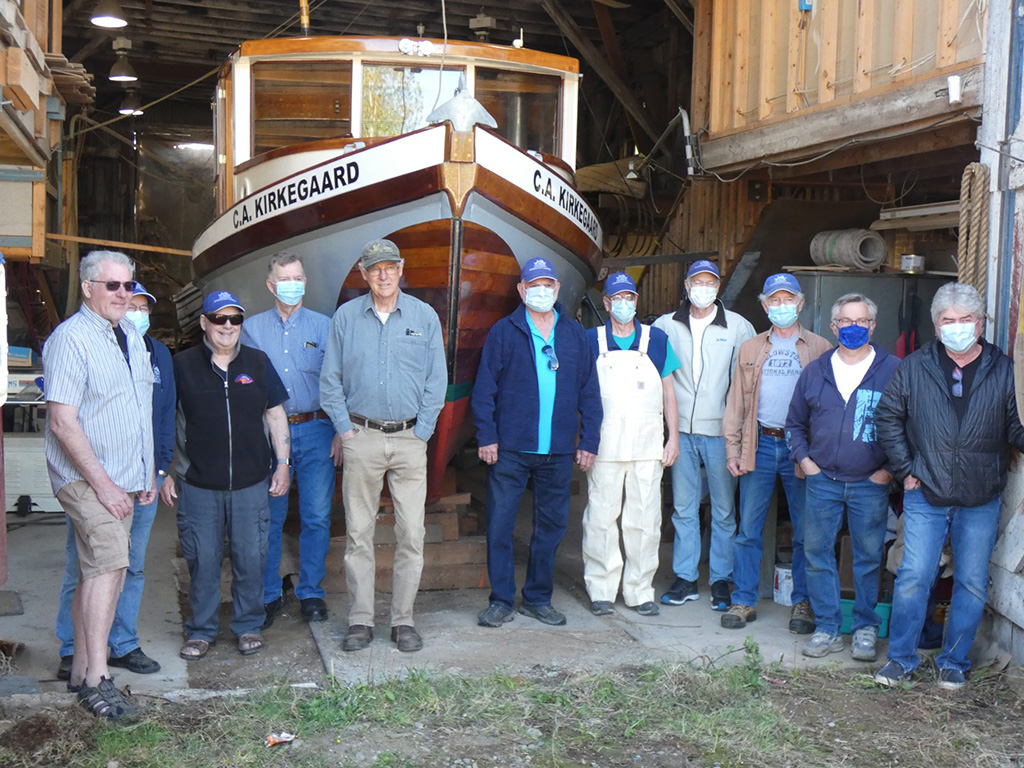
The Heritage Boat Restoration Workshop volunteers were recently awarded by the Ladysmith & District Historical Society for… “long time dedication to the restoration of heritage vessels of local importance, most recent projects including the JOAN and the C.A. KIRKEGAARD.” The Kirk was acquired by Ladysmith Maritime Society in 1992 and relaunched in 1993 after a significant restoration. She was used by LMS, for harbour tours up till 2016 when she was moved for repairs, to the historic “Car Shop.” Since then, volunteers have logged about 10,000 hours rebuilding the Kirk.
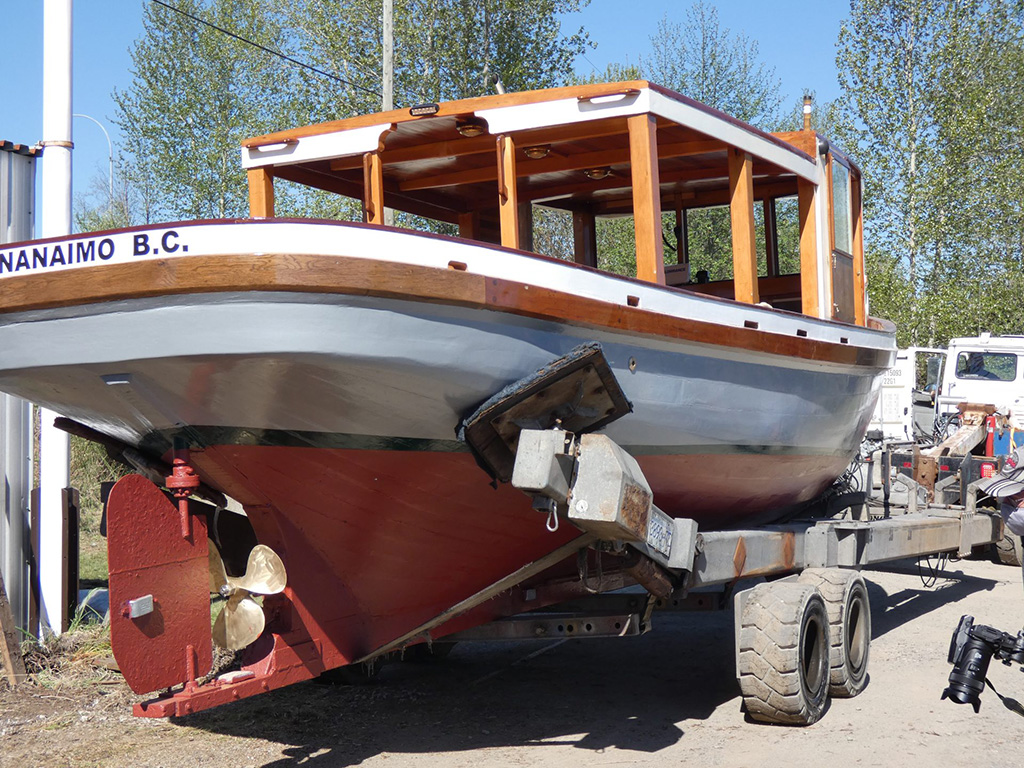
LMS volunteer Jeff Reichert has been involved in the Kirkegaard restoration since the very beginning. He said that when LMS began restoration work on the Kirkegaard in 2016 it was far from being in ship shape. Work has included replacement of the horn timber, stern timbers, stern gunwale timbers and caps, many new planks, ribs and beams, refastening of existing planks, restoration of the pilothouse windows, new cockpit combings to meet Transport Canada overflooding requirements, new cockpit deck and seats, new interior bench seats in their original configuration and new wiring. The engine was moved aft to make room for a head forwards and all new exhaust, cooling and propeller shaft connections were made.
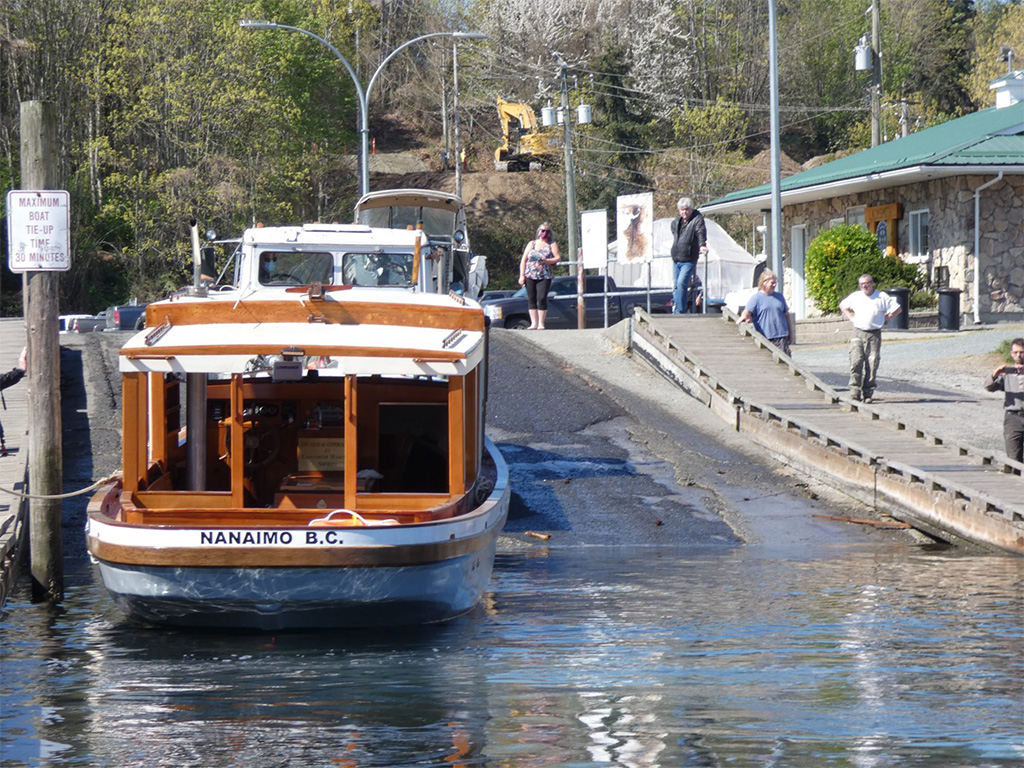
“The boat will be accessible by the public,” LMS Executive Director Richard Wiefelspuett. “It’s joining our heritage fleet now on the water and it’ll be actively used in our tour boat program where we show the harbour to paying passengers.” It will not be long now before you can once again, take a tour on the C.A. Kirkegaard!

